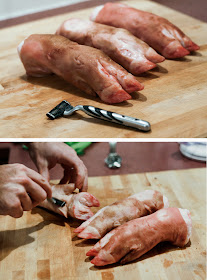What exactly is Trotter Gear?
Trotter Gear is a rich gelatinous stock made out of pork trotters.
By adding Trotter Gear to stews, sauces or soups they become richer, creamier and more flavorful.
 |
| pig's trotters - they are in fact good for something. |
I know, some of you may be grossed out by this, but I share Fergus Henderson's opinion of using all the parts of an animal, rather than just picking favorites or the best looking ones.
A piece of steak to most people does not appear to be disgusting, at all. But pig's ears, bone marrow or beef tongue are? In the end you are eating parts of an animal, whether it is a filet mignon, trotters or gummi bears.
Don't get me wrong. I would never force someone to eat something they don't feel comfortable with.
In fact, I would have a hard time eating eyes for example. Actually, I don't think I could at all...
But I do think that by being aware where your steak and BBQ-ribs come from (a whole animal with eyes, a heart, organs and, yes, feelings) it allows you to respect and appreciate (animal) life and therefore your daily piece of meat much more.
So, here is what you need for Fergus Henderson's recipe of his so-called "Healthy Jar Of Trotter Gear":
onions 2, peeled
carrots 2, peeled
celery 2 sticks
leeks 2, split
garlic 1 head
thyme a bundle
peppercorns a handful
Sercial Madeira ½ bottle (Sherry works fine, as well)
chicken stock enough to cover the trotters
Directions:
Shave the trotters! You want to get rid of all the stiff hairs...
Place the trotters in a large casserole. Cover with water and bring to the boil. Boil for 5 minutes then drain. This removes the initial scum given off by the trotters.
Now place the blanched trotters in the pot with the vegetables, thyme, peppercorns and Madeira and cover with the stock. Cook for at least 3 hours until the trotters are totally giving. At this point, strain the cooking liquid and keep.
 |
| After 3 hours the pig's trotter has mutated into an alien and is ready to get pulled apart... |
When the trotters are cool enough to handle (but don't let them go cold, as they become much harder to deal with), pick all the flesh, fat and skin off them tearing the skin to shreds.
 |
| I love pulling all the flesh, skin and fat off the bone |
Add to the cooking liquid, seal in a jar and refrigerate.
You now have trotter gear – giving, wobbly trotter captured in a splendid jelly.
For more information on Fergus Henderson and how to eat the whole beast check out his books
'Nose To Tail Eating: A Kind Of British Cooking' and 'Beyond Nose To Tail', as well as his restaurant St. John in London.
For more information on Fergus Henderson and how to eat the whole beast check out his books
'Nose To Tail Eating: A Kind Of British Cooking' and 'Beyond Nose To Tail', as well as his restaurant St. John in London.















































